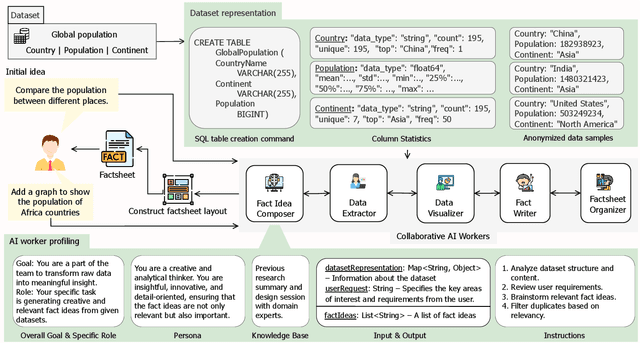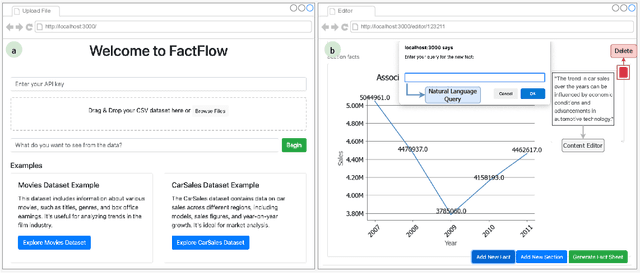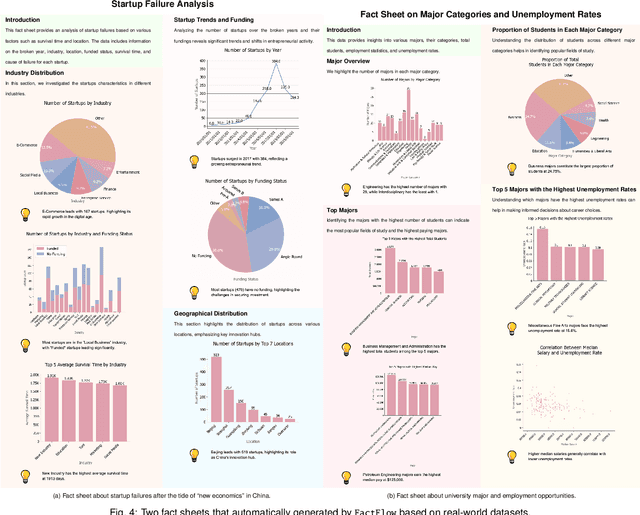Xiwei Xu
PRoH: Dynamic Planning and Reasoning over Knowledge Hypergraphs for Retrieval-Augmented Generation
Oct 14, 2025Abstract:Knowledge Hypergraphs (KHs) have recently emerged as a knowledge representation for retrieval-augmented generation (RAG), offering a paradigm to model multi-entity relations into a structured form. However, existing KH-based RAG methods suffer from three major limitations: static retrieval planning, non-adaptive retrieval execution, and superficial use of KH structure and semantics, which constrain their ability to perform effective multi-hop question answering. To overcome these limitations, we propose PRoH, a dynamic Planning and Reasoning over Knowledge Hypergraphs framework. PRoH incorporates three core innovations: (i) a context-aware planning module that sketches the local KH neighborhood to guide structurally grounded reasoning plan generation; (ii) a structured question decomposition process that organizes subquestions as a dynamically evolving Directed Acyclic Graph (DAG) to enable adaptive, multi-trajectory exploration; and (iii) an Entity-Weighted Overlap (EWO)-guided reasoning path retrieval algorithm that prioritizes semantically coherent hyperedge traversals. Experiments across multiple domains demonstrate that PRoH achieves state-of-the-art performance, surpassing the prior SOTA model HyperGraphRAG by an average of 19.73% in F1 and 8.41% in Generation Evaluation (G-E) score, while maintaining strong robustness in long-range multi-hop reasoning tasks.
Retrieval-Augmented Review Generation for Poisoning Recommender Systems
Aug 21, 2025Abstract:Recent studies have shown that recommender systems (RSs) are highly vulnerable to data poisoning attacks, where malicious actors inject fake user profiles, including a group of well-designed fake ratings, to manipulate recommendations. Due to security and privacy constraints in practice, attackers typically possess limited knowledge of the victim system and thus need to craft profiles that have transferability across black-box RSs. To maximize the attack impact, the profiles often remains imperceptible. However, generating such high-quality profiles with the restricted resources is challenging. Some works suggest incorporating fake textual reviews to strengthen the profiles; yet, the poor quality of the reviews largely undermines the attack effectiveness and imperceptibility under the practical setting. To tackle the above challenges, in this paper, we propose to enhance the quality of the review text by harnessing in-context learning (ICL) capabilities of multimodal foundation models. To this end, we introduce a demonstration retrieval algorithm and a text style transfer strategy to augment the navie ICL. Specifically, we propose a novel practical attack framework named RAGAN to generate high-quality fake user profiles, which can gain insights into the robustness of RSs. The profiles are generated by a jailbreaker and collaboratively optimized on an instructional agent and a guardian to improve the attack transferability and imperceptibility. Comprehensive experiments on various real-world datasets demonstrate that RAGAN achieves the state-of-the-art poisoning attack performance.
LLM-based HSE Compliance Assessment: Benchmark, Performance, and Advancements
May 29, 2025Abstract:Health, Safety, and Environment (HSE) compliance assessment demands dynamic real-time decision-making under complicated regulations and complex human-machine-environment interactions. While large language models (LLMs) hold significant potential for decision intelligence and contextual dialogue, their capacity for domain-specific knowledge in HSE and structured legal reasoning remains underexplored. We introduce HSE-Bench, the first benchmark dataset designed to evaluate the HSE compliance assessment capabilities of LLM. HSE-Bench comprises over 1,000 manually curated questions drawn from regulations, court cases, safety exams, and fieldwork videos, and integrates a reasoning flow based on Issue spotting, rule Recall, rule Application, and rule Conclusion (IRAC) to assess the holistic reasoning pipeline. We conduct extensive evaluations on different prompting strategies and more than 10 LLMs, including foundation models, reasoning models and multimodal vision models. The results show that, although current LLMs achieve good performance, their capabilities largely rely on semantic matching rather than principled reasoning grounded in the underlying HSE compliance context. Moreover, their native reasoning trace lacks the systematic legal reasoning required for rigorous HSE compliance assessment. To alleviate these, we propose a new prompting technique, Reasoning of Expert (RoE), which guides LLMs to simulate the reasoning process of different experts for compliance assessment and reach a more accurate unified decision. We hope our study highlights reasoning gaps in LLMs for HSE compliance and inspires further research on related tasks.
Hydra: Structured Cross-Source Enhanced Large Language Model Reasoning
May 23, 2025Abstract:Retrieval-augmented generation (RAG) enhances large language models (LLMs) by incorporating external knowledge. Current hybrid RAG system retrieves evidence from both knowledge graphs (KGs) and text documents to support LLM reasoning. However, it faces challenges like handling multi-hop reasoning, multi-entity questions, multi-source verification, and effective graph utilization. To address these limitations, we present Hydra, a training-free framework that unifies graph topology, document semantics, and source reliability to support deep, faithful reasoning in LLMs. Hydra handles multi-hop and multi-entity problems through agent-driven exploration that combines structured and unstructured retrieval, increasing both diversity and precision of evidence. To tackle multi-source verification, Hydra uses a tri-factor cross-source verification (source trustworthiness assessment, cross-source corroboration, and entity-path alignment), to balance topic relevance with cross-modal agreement. By leveraging graph structure, Hydra fuses heterogeneous sources, guides efficient exploration, and prunes noise early. Comprehensive experiments on seven benchmark datasets show that Hydra achieves overall state-of-the-art results on all benchmarks with GPT-3.5, outperforming the strong hybrid baseline ToG-2 by an average of 20.3% and up to 30.1%. Furthermore, Hydra enables smaller models (e.g., Llama-3.1-8B) to achieve reasoning performance comparable to that of GPT-4-Turbo.
Get the Agents Drunk: Memory Perturbations in Autonomous Agent-based Recommender Systems
Mar 31, 2025Abstract:Large language model-based agents are increasingly used in recommender systems (Agent4RSs) to achieve personalized behavior modeling. Specifically, Agent4RSs introduces memory mechanisms that enable the agents to autonomously learn and self-evolve from real-world interactions. However, to the best of our knowledge, how robust Agent4RSs are remains unexplored. As such, in this paper, we propose the first work to attack Agent4RSs by perturbing agents' memories, not only to uncover their limitations but also to enhance their security and robustness, ensuring the development of safer and more reliable AI agents. Given the security and privacy concerns, it is more practical to launch attacks under a black-box setting, where the accurate knowledge of the victim models cannot be easily obtained. Moreover, the practical attacks are often stealthy to maximize the impact. To this end, we propose a novel practical attack framework named DrunkAgent. DrunkAgent consists of a generation module, a strategy module, and a surrogate module. The generation module aims to produce effective and coherent adversarial textual triggers, which can be used to achieve attack objectives such as promoting the target items. The strategy module is designed to `get the target agents drunk' so that their memories cannot be effectively updated during the interaction process. As such, the triggers can play the best role. Both of the modules are optimized on the surrogate module to improve the transferability and imperceptibility of the attacks. By identifying and analyzing the vulnerabilities, our work provides critical insights that pave the way for building safer and more resilient Agent4RSs. Extensive experiments across various real-world datasets demonstrate the effectiveness of DrunkAgent.
Unlocking Multi-Modal Potentials for Dynamic Text-Attributed Graph Representation
Feb 27, 2025



Abstract:Dynamic Text-Attributed Graphs (DyTAGs) are a novel graph paradigm that captures evolving temporal edges alongside rich textual attributes. A prior approach to representing DyTAGs leverages pre-trained language models to encode text attributes and subsequently integrates them into dynamic graph models. However, it follows edge-centric modeling, as in dynamic graph learning, which is limited in local structures and fails to exploit the unique characteristics of DyTAGs, leading to suboptimal performance. We observe that DyTAGs inherently comprise three distinct modalities-temporal, textual, and structural-often exhibiting dispersed or even orthogonal distributions, with the first two largely overlooked in existing research. Building on this insight, we propose MoMent, a model-agnostic multi-modal framework that can seamlessly integrate with dynamic graph models for structural modality learning. The core idea is to shift from edge-centric to node-centric modeling, fully leveraging three modalities for node representation. Specifically, MoMent presents non-shared node-centric encoders based on the attention mechanism to capture global temporal and semantic contexts from temporal and textual modalities, together with local structure learning, thus generating modality-specific tokens. To prevent disjoint latent space, we propose a symmetric alignment loss, an auxiliary objective that aligns temporal and textual tokens, ensuring global temporal-semantic consistency with a theoretical guarantee. Last, we design a lightweight adaptor to fuse these tokens, generating comprehensive and cohesive node representations. We theoretically demonstrate that MoMent enhances discriminative power over exclusive edge-centric modeling. Extensive experiments across seven datasets and two downstream tasks show that MoMent achieves up to 33.62% improvement against the baseline using four dynamic graph models.
FactFlow: Automatic Fact Sheet Generation and Customization from Tabular Dataset via AI Chain Design & Implementation
Feb 25, 2025



Abstract:With the proliferation of data across various domains, there is a critical demand for tools that enable non-experts to derive meaningful insights without deep data analysis skills. To address this need, existing automatic fact sheet generation tools offer heuristic-based solutions to extract facts and generate stories. However, they inadequately grasp the semantics of data and struggle to generate narratives that fully capture the semantics of the dataset or align the fact sheet with specific user needs. Addressing these shortcomings, this paper introduces \tool, a novel tool designed for the automatic generation and customisation of fact sheets. \tool applies the concept of collaborative AI workers to transform raw tabular dataset into comprehensive, visually compelling fact sheets. We define effective taxonomy to profile AI worker for specialised tasks. Furthermore, \tool empowers users to refine these fact sheets through intuitive natural language commands, ensuring the final outputs align closely with individual preferences and requirements. Our user evaluation with 18 participants confirms that \tool not only surpasses state-of-the-art baselines in automated fact sheet production but also provides a positive user experience during customization tasks.
Foundation Models for Anomaly Detection: Vision and Challenges
Feb 10, 2025



Abstract:As data continues to grow in volume and complexity across domains such as finance, manufacturing, and healthcare, effective anomaly detection is essential for identifying irregular patterns that may signal critical issues. Recently, foundation models (FMs) have emerged as a powerful tool for advancing anomaly detection. They have demonstrated unprecedented capabilities in enhancing anomaly identification, generating detailed data descriptions, and providing visual explanations. This survey presents the first comprehensive review of recent advancements in FM-based anomaly detection. We propose a novel taxonomy that classifies FMs into three categories based on their roles in anomaly detection tasks, i.e., as encoders, detectors, or interpreters. We provide a systematic analysis of state-of-the-art methods and discuss key challenges in leveraging FMs for improved anomaly detection. We also outline future research directions in this rapidly evolving field.
On LLM-Enhanced Mixed-Type Data Imputation with High-Order Message Passing
Jan 04, 2025



Abstract:Missing data imputation, which aims to impute the missing values in the raw datasets to achieve the completeness of datasets, is crucial for modern data-driven models like large language models (LLMs) and has attracted increasing interest over the past decades. Despite its importance, existing solutions for missing data imputation either 1) only support numerical and categorical data or 2) show an unsatisfactory performance due to their design prioritizing text data and the lack of key properties for tabular data imputation. In this paper, we propose UnIMP, a Unified IMPutation framework that leverages LLM and high-order message passing to enhance the imputation of mixed-type data including numerical, categorical, and text data. Specifically, we first introduce a cell-oriented hypergraph to model the table. We then propose BiHMP, an efficient Bidirectional High-order Message-Passing network to aggregate global-local information and high-order relationships on the constructed hypergraph while capturing the inter-column heterogeneity and intra-column homogeneity. To effectively and efficiently align the capacity of the LLM with the information aggregated by BiHMP, we introduce Xfusion, which, together with BiHMP, acts as adapters for the LLM. We follow a pre-training and fine-tuning pipeline to train UnIMP, integrating two optimizations: chunking technique, which divides tables into smaller chunks to enhance efficiency; and progressive masking technique, which gradually adapts the model to learn more complex data patterns. Both theoretical proofs and empirical experiments on 10 real world datasets highlight the superiority of UnIMP over existing techniques.
From Exploration to Revelation: Detecting Dark Patterns in Mobile Apps
Nov 27, 2024Abstract:Mobile apps are essential in daily life, yet they often employ dark patterns, such as visual tricks to highlight certain options or linguistic tactics to nag users into making purchases, to manipulate user behavior. Current research mainly uses manual methods to detect dark patterns, a process that is time-consuming and struggles to keep pace with continually updating and emerging apps. While some studies targeted at automated detection, they are constrained to static patterns and still necessitate manual app exploration. To bridge these gaps, we present AppRay, an innovative system that seamlessly blends task-oriented app exploration with automated dark pattern detection, reducing manual efforts. Our approach consists of two steps: First, we harness the commonsense knowledge of large language models for targeted app exploration, supplemented by traditional random exploration to capture a broader range of UI states. Second, we developed a static and dynamic dark pattern detector powered by a contrastive learning-based multi-label classifier and a rule-based refiner to perform detection. We contributed two datasets, AppRay-Dark and AppRay-Light, with 2,185 unique deceptive patterns (including 149 dynamic instances) across 18 types from 876 UIs and 871 benign UIs. These datasets cover both static and dynamic dark patterns while preserving UI relationships. Experimental results confirm that AppRay can efficiently explore the app and identify a wide range of dark patterns with great performance.
 Add to Chrome
Add to Chrome Add to Firefox
Add to Firefox Add to Edge
Add to Edge